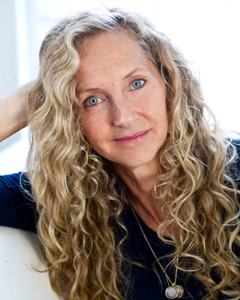Note: Lily King’s Euphoria was WINNER of the Kirkus Prize for Best Novel of 2014. King was also WINNER of the New England Book Award for Father of the Rain in 2010, and has received both a Whiting Award for fiction and a MacDowell Colony Fellowship.
“I think above all else it is freedom I search for in my work, in these far-flung places, to find a group of people who give each other the room to be in whatever way they need to be. And maybe I will never find it all in one culture but maybe I can find parts of it in several cultures, maybe I can piece it together like a mosaic and unveil it to the world…[though] I fear that [my] awareness of their impending doom alters my observations.”—Nell Stone, anthropologist in New Guinea, 1933.
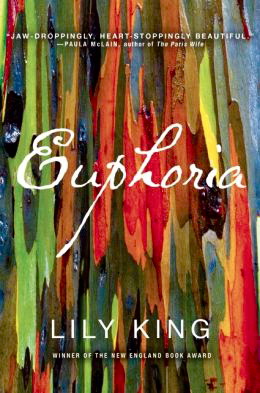 In this breakthrough novel, Lily King abandons the focus of her previous novels, which have always delved deeply into the subjects of love, family relationships, and personal identity within a narrow, circumscribed setting involving one major character. Her first book, The Pleasing Hour (2000), tells the story of an American au pair in Paris and her difficult relationships with the family for which she works. The English Teacher (2005) depicts a long-time teacher and her fifteen-year-old son who live on an island off the New England coast until the teacher accepts a marriage proposal, which changes all their lives. In Father of the Rain (2010), she analyzes how a woman’s unresolved issues regarding her need and love for her alcoholic and irresponsible father affect her own life over the course of forty years. In all these novels, King thoroughly and effectively examines a “world writ small.”
In this breakthrough novel, Lily King abandons the focus of her previous novels, which have always delved deeply into the subjects of love, family relationships, and personal identity within a narrow, circumscribed setting involving one major character. Her first book, The Pleasing Hour (2000), tells the story of an American au pair in Paris and her difficult relationships with the family for which she works. The English Teacher (2005) depicts a long-time teacher and her fifteen-year-old son who live on an island off the New England coast until the teacher accepts a marriage proposal, which changes all their lives. In Father of the Rain (2010), she analyzes how a woman’s unresolved issues regarding her need and love for her alcoholic and irresponsible father affect her own life over the course of forty years. In all these novels, King thoroughly and effectively examines a “world writ small.”
There is nothing small-scale about King’s new novel, Euphoria, however. Here she creates a novel on the grandest scale in terms of themes and ideas, at the same time that she also dramatically changes the time frame and setting from her previous locales, familiar to the reader, to areas of New Guinea so remote that they have never been explored by “outsiders.” American anthropologist Nell Stone and her Australian husband, anthropologist Schuyler Fenwick, have been in New Guinea since 1931, and now, almost two years later, Nell is more than ready for change. For the past six months they have been studying the warlike and cannibalistic Mumbanyo tribe, though most of that study has been done by Fen. Fen’s specialties have always been religion, religious totems, religious ceremonies, warfare, and genealogy while Nell’s interests have been economics, food, government, social structure, and child-rearing. Now, however, she is weary and frightened of the fearsome Mumbanyos with their bloodlust and their penchant for discarding babies in the river.
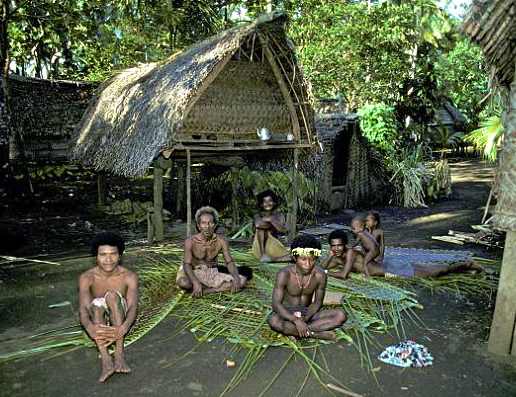
A New Guinea family. Their dramatic and difficult story is told in a link given in the photo credits.
King creates a vibrant novel, starting with a dramatic and evocative first chapter, which explodes with information as Nell and Fen are being propelled down the river toward a port. They plan to leave New Guinea now and go to Australia to study an aborigine group. The trip, which describes some aspects of their lives with the Mumbanyos, also establishes the themes, stressing the enormous cultural contrasts between their goals and the goals of some of the more “civilized” passengers in this small boat – including British overseers of plantations and mines and their elegantly dressed wives. One woman’s references to a “shocking” book published in England about “all the children fornicating in the bushes” in the Solomon Islands hints at the success of Nell’s earlier published research, while also telling her about its reception by the Br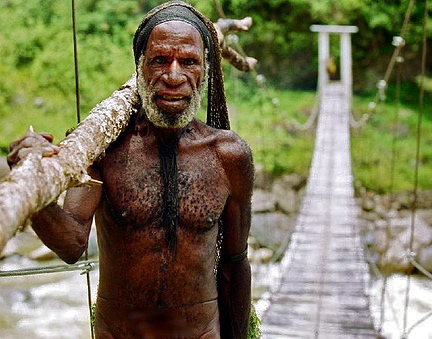 itish public. Fen’s treatment of her on the boat suggests that their relationship has not been a true partnership, and the tension is palpable.
itish public. Fen’s treatment of her on the boat suggests that their relationship has not been a true partnership, and the tension is palpable.
Their boat is met by Andrew Bankson, a British anthropologist they had previously met in Sydney and who has been doing research in New Guinea for several years. His life has been depressingly lonely, and he is desperate to have fellow researchers “nearby” with whom he can talk. Eventually, Nell and Fen decide to stay in New Guinea, studying a new tribe upriver from Bankson’s camp.
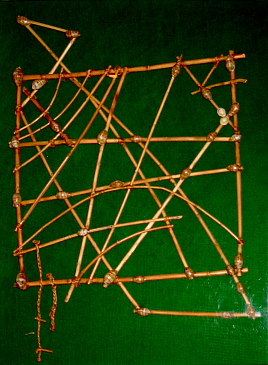
Tribes often made maps for navigating on the water, with shells representing islands and bamboo slats representing currents.
The point of view then shifts to that of Bankson, who offers his own commentary on the action and on the other characters. Additional points of view, including that of Nell, continue to appear throughout, as the time frames shift to provide new information. The use of letters and the characters’ reminiscences fill in details of the past and bring the characters to life. As the relationships (and in some cases, rivalries) among Nell Stone, Schuyler Fenwick, and Andrew Bankson become more personal when they have only each other for company, Bankson asks Nell what is her favorite part of her work. Surprised, she remarks, “It’s the moment about two months in when you think you’ve finally got a handle on the place. Suddenly it feels within your grasp. It’s a delusion…But at that moment the place feels entirely yours. It’s the briefest, purest euphoria.” Before long, the characters’ relationships become still more intimate, leading to a sexually intense atmosphere, which King develops in explicit detail.
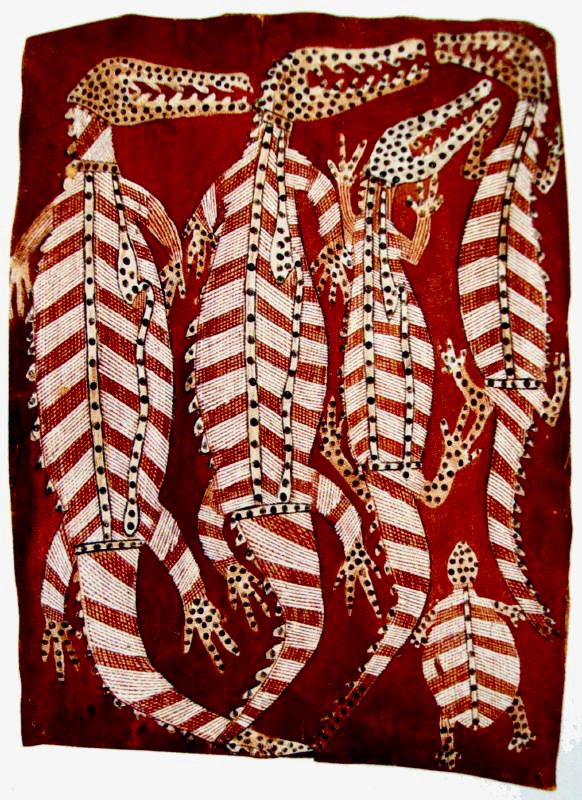
Crocodiles painted on eucalyptus bark. Bankson’s Kiona tribe had “crocodile origins and a cannibal past.”
The author makes no secret of the fact that she has used the lives of anthropologists Margaret Mead, her husband Reo Fortune, and Gregory Bateson during their several months together in 1933 on the Sepik River in New Guinea as the models for Nell, Fen, and Bankson, and one need only go to Wikipedia to find out just how closely the activities of these scientists parallel the action of the novel. Though King reminds the reader that this is a work of fiction, her extensive research into the lives of these scientists helps bring the novel’s characters to life and makes their commitment to their work understandable and realistic. Ultimately, however, it is King who guides the story, not a biographer. It is she who makes all the decisions about what to include, what to omit, and what to emphasize; and she is the one who orders the information and controls the outcomes, some of which are different from what one reads in the biographies. Her careful eye and acute sensitivity to detail bring an alien landscape to life for the reader while also allowing her to explore ideas in new ways, and she does all this with great panache. Though some may quibble about the difficulty of following the shifting points of view at the beginning of this unusual novel, Euphoria is dramatic and rewarding, a book which beautifully illustrates Nell Stone’s belief that “our perspective can have an enormous wingspan, if we give it the freedom to unfurl.”
ALSO by Lily King: FATHER OF THE RAIN
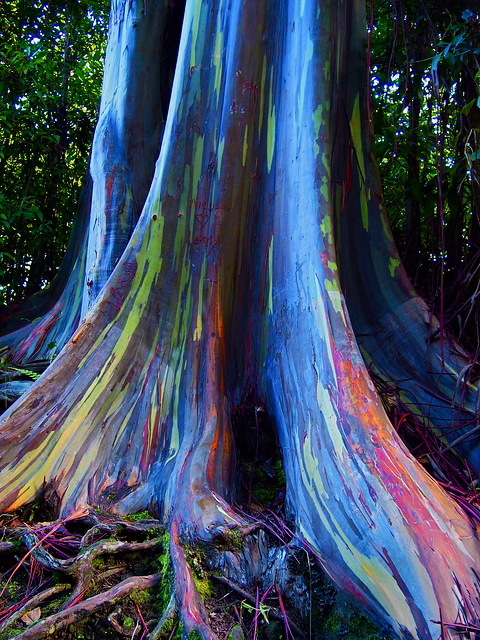
The book’s cover shows the bark of a rainbow eucalyptus. This blue eucalyptus is also found in New Guinea. These are natural colors
Photos, in order: The author’s photo appears on http://www.bookpassage.com
The family in the photo is protecting a young girl who was raped viciously by her father. Her response was to behead him. The family and the village are protecting her from “authorities.” The story, from 2013, is here: http://www.dailymail.co.uk/
A male tribesman from New Guinea stands in front of a hanging bridge: http://commons.wikimedia.org
Maps made from bamboo and shells have been used throughout the South Pacific, from Hawaii to New Guinea: http://critiki.com
This beautiful aboriginal bark painting by Mick Kubaku is found on http://www.artrecord.com/
The cover of this book shows the bark of a rainbow eucalyptus. This last photo shows a blue eucalyptus, part of the same tree family. These are natural colors. http://www.factrange.com/
